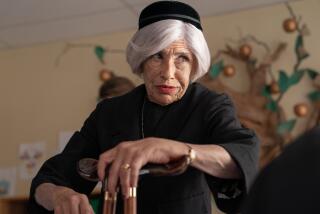Opening a Door to Panic Rooms
- Share via
In David Fincher’s new thriller “Panic Room,” Jodie Foster and her teenage daughter cower in a small fortress just off the bedroom of her multi-story New York apartment, hidden from a trio of robbers downstairs. Their elaborate dungeon is small, but it’s equipped with food, water, florescent lighting, fire blankets and a phone.
Panic rooms like the one in the film can be found in new homes--and home improvements--from mansions in Los Angeles to brownstones in New York to flats in London, as well as other parts of the world.
Panic rooms have been installed in nearly every new home inside the “privileged triangle” of Bel-Air, Beverly Park and Holmby Hills (where the Playboy Mansion sits), according to Bill Rigdon, one of the owners of Building Consensus, a local architectural, design, engineering and security firm. Rigdon says some panic rooms are minimalist annexes and some are luxurious hideaways, but every one was conceived as an impenetrable barrier between a homeowner and an armed intruder.
In the film, which opens Friday, Foster and her daughter run to the panic room for protection after a break-in. It’s supposed to be foolproof, but as Fincher notes, panic rooms are only as good as the human in charge of them.
“I stayed in an apartment in London in the early ‘90s, and it had a panic room, and I proceeded to set the alarm off almost biweekly,” he said. “So, I was instructed not to set the alarm, because I couldn’t be trusted not to set it off, defeating the entire purpose.”
And that’s the catch. Panic rooms must be the homeowner’s secret passageway to safety. Architects do not tell contractors what they’re building, and homeowners--if they are serious about their investment--refrain from making the panic room part of the tour before a dinner party.
Since the terrorist attacks of Sept. 11, orders for panic rooms have soared, according to Rigdon. “These people are scared,” he said, noting that he and his crew sign 10-page confidentiality agreements with clients. “The people who were scared to begin with are even more scared right now.”
Rigdon says his clients have paid between $50,000 to $500,000 for a room that somehow speaks to their individual fears. He built one room that was wired to a sensor affixed to a small, decorative pendant around the homeowner’s neck. Once the home’s external security system was breached, the door to the panic room would remain on alert for the sensor to pass over its threshold. With the sensor-wearing resident safely over the threshold, the heavy door automatically pulled shut behind him or her. .
Perhaps the best-known panic room expert is Gavin de Becker, who has built thousands of high-tech havens since 1978 and who consulted with Fincher for “Panic Room.” In an e-mail from Fiji earlier this month, De Becker said the confidentiality of panic rooms is so critical that the owners usually tear them down when the house goes on the market, so that neither real estate agents nor prospective buyers see evidence of the owner’s fears.
That means, some experts say, catering to people who are less concerned with thwarting a crime than with quelling their own formidable anxieties. Nan Ellin, associate professor in the School of Architecture in Arizona State University and author of “Architecture of Fear” (1997), believes panic rooms are most appealing to parents. “The most fearful demographics are young mothers. The second most fearful demographics are young fathers,” Ellin says. “So, put them together with money and you’ve got a good formula for someone who wants a saferoom.”
Others are more skeptical and dismiss the panic room phenomenon as largely urban myth.
Roger K. Lewis, a practicing architect in Washington, D.C., for 33 years, a professor of architecture at the University of Maryland and author of “Shaping the City,” a column in the Washington Post, has never seen one.
“I’ve designed a lot of houses, and I’ve never been asked to include one in the designs,” he said. “My impression is that the only person who would build a so-called panic room is someone who is paranoid.”
In the first scene of “Panic Room,” Foster’s character, Meg Altman, appears tense and vulnerable. Altman is a woman of privilege whose cheating husband has left her with no place to stash the Bordeaux stemware. A real estate agent shows her a massive townhouse-brownstone, (he calls it a “townstone,”) with four floors, several bedrooms, a functioning elevator and the panic room.
“She’s repelled by it,” said the film’s writer, David Koepp. “She’s on a tilt, with her marriage ending, and she overreacts. Why did she choose such an unsuitable place for her? Panic, the clouded judgment in panic.”
According to Fincher, who admits he lives in a gated community, the movie is something of a personal parable from Koepp, whose marriage was on the rocks when he wrote it.
“The movie is a lot about divorce, the destruction of home, the choices you make that lead you to standing in your home with all the plaster dust and holes,” Fincher said. “I had to give him little pointers on how those conversations might be. He had written a lot of people doing the best they can in a bad situation, and I had to explain to him that sometimes people behave badly.”
As is typical for a Fincher film (he directed “Fight Club” and “Seven”), “Panic Room” aims to make audiences uncomfortable. To play up this creepy feeling, cinematographer Conrad W. Hall used cold, sometimes greenish light as the movie progressed. It was not a flattering method of lighting Academy Award winner Foster, but the florescent hue effectively helped turn her from the hunted, jilted wife into the strategic huntress.
In real life, Foster said she knows no one with a panic room--she doesn’t even have a bodyguard, she said in a recent interview. But Foster’s personal security has been public fare since 1981, when, during her sophomore year at Yale University, an obsessed fan named John Hinckley Jr. opened fire on President Reagan outside the Hilton Hotel in Washington. He later explained it was his way of proving his love to the young actress. But now, Foster brushes aside a mention of Hinckley, volunteering that she doesn’t have a panic room or bodyguards.
“I feel safe. I’m not a particularly paranoid person,” she said, calmly looking through her rectangle-framed glasses. “Burglars are a little different than stalker assassins.”
Besides, she noted, “Panic Room” has less to do with safety than with intimate relationships.
“Metaphorically, it’s about two kinds of couples who don’t see one another,” she noted. “There’s a big door between the two of them, and each one of them comes with a total mistrust because of their history,” Foster said. “They start out kind of bumbling, but by the end they’re vicious because one person has to take the other one down.”
The fact that Foster is starring in the film at all is something of a fluke; Nicole Kidman was supposed to play the role but had to drop out because of a knee injury sustained during the making of “Moulin Rouge.” So Foster agreed to replace her.
The film took six months to shoot, and when they wrapped, Foster was entering the third trimester of her pregnancy (she had her second son in September).
“The last scene we shot of her is the first scene in the movie, when she’s looking at the house,” Fincher said. “She’s six months pregnant, wearing a huge coat and carrying a ‘Kelly bag,’ which coincidentally was designed to hide Grace Kelly’s pregnancy. [The purse] is held by both hands and perched right in front of her stomach.”
Even that scene was a late addition. Koepp had originally wanted to restrict Foster and the robbers (played by Dwight Yoakam, Jared Leto and Forest Whitaker), to within the confines of the townhouse. It was an economical and manageable filmmaking process that kept its budget in the “low 40 millions,” according to Koepp.
“In the first draft, I never wanted to leave the house. Ever,” he said. “You’re being buried alive in your own house.”
But that confinement became too claustrophobic, even for Fincher, and for the final scene they let some of the characters out into the daylight--into a city of millions that harbors an unknowable number of panic rooms.
More to Read
The biggest entertainment stories
Get our big stories about Hollywood, film, television, music, arts, culture and more right in your inbox as soon as they publish.
You may occasionally receive promotional content from the Los Angeles Times.










